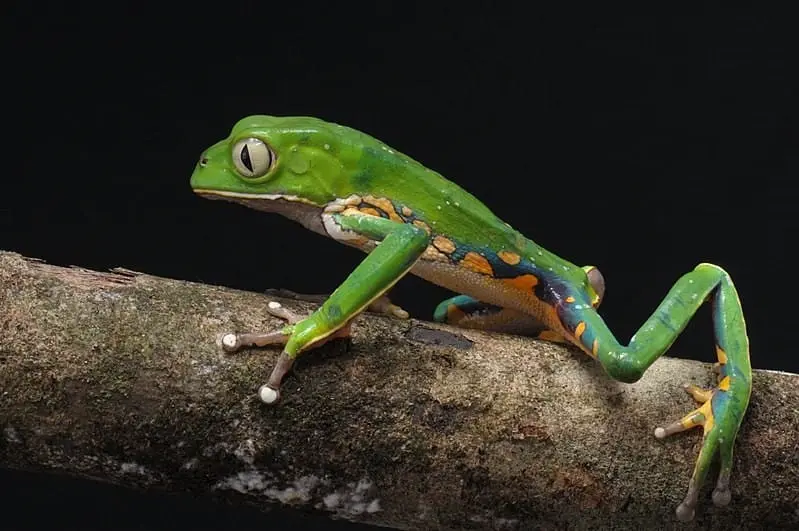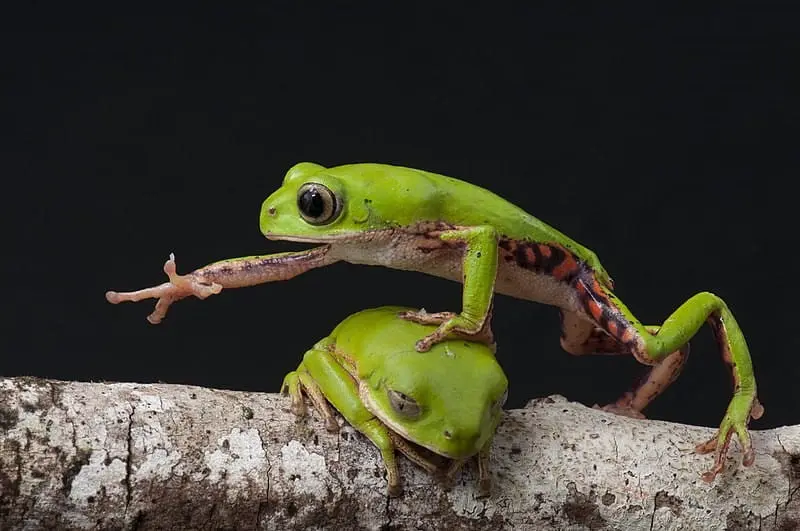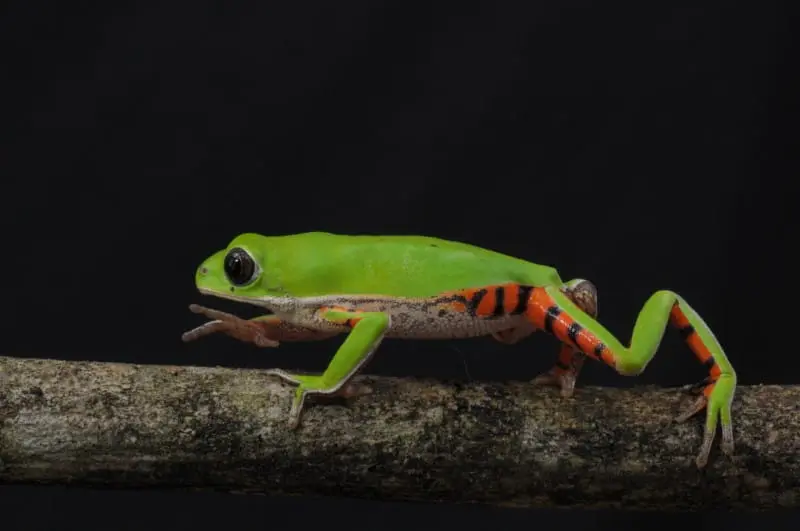The friendly leaf frogs
Leaf frogs are probably the most charismatic and best known anurans to people in general. They are part of the family Phyllomedusidae, where “phyllo” means leaf or foliage and “medusa” means queen or protector, so it means “queen of the foliage” or “guardian of the foliage.”
Taxonomy and Discoveries
Until recently, leaf frogs were part of another family - the hylids. However, after observations in morphological and behavioral differences, their own family was created in 2016 - the Phyllomedusidae.
Leaf frogs can be very similar to each other, both physically and genetically. Therefore, over the past decade, scientists and scholars have corrected the genus of several species that were initially misclassified, and many still need further study to be properly named.
In addition to analyses of already known species, about 11 new species have been discovered since the 2000s,1 which means that new classifications are made every year - increasing the number of species to be studied.
Distribution

Leaf frogs are present in Central and South America. In Brazil about 42 species in 6 genera are found throughout the country1. According to the IUCN Red List of Threatened Species, those of the genus Phasmahyla and Phrynomedusa are found only in the Atlantic Forest. The leaf frogs of Callimedusa and Cruziohyla genus inhabit the Amazon Rainforest. Hylomantis are found in the Caatinga and Atlantic Forest.
Those of the genus Phyllomedusa are the most diverse, both in number of species and in habitats, and can be found in all biomes. The genus Pithecopus is also found throughout Brazil, with the exception of the Pampas - where only the species Phyllomedusa iheringii is found.
General Characteristics
Leaf frogs can measure up to 12 cm (4,7 in) (Phyllomedusa bicolor), the females are always a little larger than the males. Most are arboreal, but some can be found in fields or rocky areas, always near a body of water, either a low flow stream or a temporary puddle.
These frogs have some characteristics that distinguish them from other anurans. One of them is the habit of laying their eggs not in the water, but on leaves that are rolled up above the surface, and when the tadpoles are born, they immediately slip into the water. Although this method protects the eggs from aquatic predators, it is not foolproof, and some end up being parasitized2 or eaten by other animals.

They are also distinguished by their vertical pupils, by the fact that they walk and not just jump like other anurans, and by their typical green coloration on the upper body and colored on the lower body. To camouflage themselves, several species such as Pithecopus nordestinus (discovered in 2006), Phasmahyla lisbella (discovered in 2018)3 and Phasmahyla guttata can even change their coloration from light green to brownish, depending on the location and the brightness of the environment.4
The coloration of the underside, on the other hand, is called “aposematic coloration” - a very common defense mechanism in anurans, and acts as a warning to potential predators that eating them could be dangerous.4
Secretion of substances
Almost all anurans produce some type of secretion or toxin. The secretions produced by leaf frogs prevent dehydration and protect them from disease and predators by causing unpleasant sensations such as regurgitation, altered heart rate, or temporary paralysis.
Some of the substances produced have been studied by researchers for decades as having medicinal properties to prevent infection during blood transfusions5, in the treatment of leishmaniasis6 and HIV. In addition, the secretions of leaf frogs could also be used as hypotensives, vasodilators, antibiotics, analgesics, and opioids if they are properly isolated and all their risks are studied7.
Toxicity in humans

Unlike harmful frogs, such as poison dart frogs , most leaf frogs pose no danger to humans and can be handled. However, the secretion that some species produce, specifically the kambô frog (Phyllomedusa bicolor) - found in the Amazon Rainforest, can cause adverse reactions if in contact with any mucous membranes or wounds.
The effects of the secretion on humans have been observed in studies with various indigenous communities, where the secretion is extracted from the kambô frog without killing it and then applied to small burns - usually on the person’s arm or leg. According to indigenous traditions, this ritual stops bad luck in hunting and fishing, and removes (through vomiting) negative spirits that cause illness.
Media exploitation of this ritual has made it a sought-after practice in large urban centers as an alternative treatment for those seeking strength, endurance, and even a cure for depression and cancer. However, this method has no scientific proof and causes a series of adverse reactions such as vomiting, diarrhea, sweating, changes in blood pressure and tachycardia, which can lead to death in many people due to overdose or allergy to certain substances contained in the secretion of the tree frog.
Because of this danger to human life, Anvisa has banned all advertising of the “frog vaccine” since 2004.8
Threats and Conservation
Most of the leaf frogs is listed on the IUCN Red List of Threatened Species as “Data Deficient” or “Least Concern”. However, accurate data on conservation status is scarce, as many species were last assessed more than a decade ago. As a result, their current conservation status is unknown.
Certain species are endemic and occur in isolated locations where increased deforestation could drive them to extinction quickly. At a slower rate, species with wider distributions may also be threatened by deforestation and fire.
However, some species live in protected areas in Brazil or neighboring countries, have a wide distribution and are easy to find.
Read more:
-
Segalla, M; Berneck, B.;Canedo, C.; Caramaschi, U.; Cruz, C.A.G.; Garcia, P. C. A.; Grant, T.; Haddad, C. F. B.; Lourenço, A. C.; Mangia, S.; Mott, T.; Nascimento, L. Toledo, L. F.; Werneck, F.; Langone, J. A. (2021). List of Brazilian Amphibians. Herpetologia Brasileira, 10(1), 121–216. ↩︎
-
Dias, Tailise & Santos, Tiago & Maragno, Franciéle & Oliveira, Vitor & Lima, Carin & Cechin, Sonia. (2017). Breeding biology, territoriality, and reproductive site use by Phyllomedusa iheringii (Anura: Phyllomedusidae) from the South American Pampa in Brazil. Salamandra. 53. 257-266. ↩︎
-
Pereira EA, Rocha LCL, Folly H, da Silva HR, Santana DJ. A new species of spotted leaf frog, genus Phasmahyla (Amphibia, Phyllomedusidae) from Southeast Brazil. PeerJ. 2018 May 30;6:e4900. doi: 10.7717/peerj.4900. PMID: 29868290; PMCID: PMC5984584. ↩︎
-
Machado, Ibere & Menegucci, Rafael & Mendes, Humberto & Moroti, Matheus. (2015). Polyphenism: Defensive colour behaviour of Phasmahyla guttata (A. Lutz, 1924) (Amphibia, Anura, Hylidae. Herpetology Notes. 8. 467-470. ↩︎
-
Brand GD, Leite JR, Silva LP, Albuquerque S, Prates MV, Azevedo RB, Carregaro V, Silva JS, Sá VC, Brandão RA, Bloch C Jr. Dermaseptins from Phyllomedusa oreades and Phyllomedusa distincta. Anti-Trypanosoma cruzi activity without cytotoxicity to mammalian cells. J Biol Chem. 2002 Dec 20;277(51):49332-40. doi: 10.1074/jbc.M209289200. Epub 2002 Oct 11. PMID: 12379643. ↩︎
-
Correio Braziliense - Substância da Phyllomedusa nordestina elimina o protozoário da Leishmaniose ↩︎
-
Nogueira TAC, Kaefer IL, Sartim MA, Pucca MB, Sachett J, Barros AL, Júnior MBA, Baía-da-Silva DC, Bernarde PS, Koolen HHF and Monteiro WM (2022). The Amazonian kambô frog Phyllomedusa bicolor (Amphibia: Phyllomedusidae): Current knowledge on biology, phylogeography, toxinology, ethnopharmacology and medical aspects. Front. Pharmacol. 13:997318. doi: 10.3389/fphar.2022.997318 ↩︎
-
Exame - Instituto Butɑntan alerta sobre riscos da ‘vacina-do-sapo’ ↩︎
